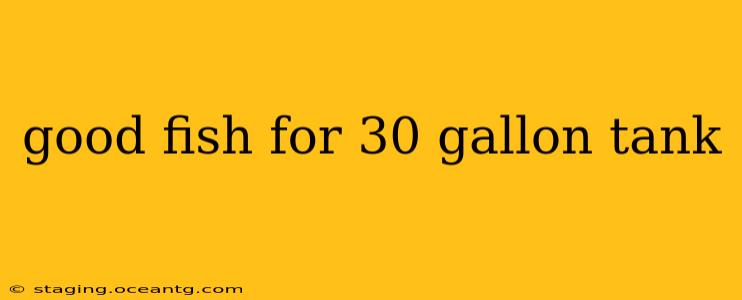A 30-gallon tank opens up a world of possibilities for fishkeeping! It's large enough to accommodate a variety of species and create a thriving aquatic ecosystem. However, choosing the right fish is crucial for their well-being and the overall health of your tank. This guide will help you select the perfect inhabitants for your 30-gallon aquarium. We'll cover various species, consider their compatibility, and address common concerns to ensure a successful and enjoyable fishkeeping experience.
What Size Fish Should I Get for a 30-Gallon Tank?
This is a fundamental question. You shouldn't overcrowd your tank. A good rule of thumb is the "one-inch-per-gallon" rule, but this is a guideline, not a hard and fast rule. Some fish need more space than others, and this rule doesn't account for waste production or the fish's adult size. It's better to err on the side of caution and understock your tank. Think about the adult size of your chosen fish; a small fish that grows large will quickly overcrowd a 30-gallon tank.
What Kind of Fish Are Good for a 30-Gallon Tank?
Many fantastic fish thrive in a 30-gallon tank. Here are a few categories and examples:
Small, Peaceful Community Fish:
- Tetras: Various tetra species, such as neon tetras, cardinal tetras, and black skirt tetras, are vibrant, schooling fish that add color and activity to the tank. Remember they need to be kept in schools of at least six.
- Rasboras: Similar to tetras, rasboras are peaceful and active schooling fish. Harlequin rasboras and chili rasboras are popular choices.
- Corydoras Catfish: These bottom-dwelling catfish are peaceful and help keep the tank clean by scavenging for leftover food. They add a unique dimension to the community.
- Dwarf Gourami: These colorful fish are relatively peaceful, but only one male should be kept per tank, as males are territorial.
Semi-Aggressive Fish (Careful Community Selection Needed):
- Rainbowfish: These elegant fish add a splash of color and are relatively peaceful, but some species can become more aggressive with other similar-sized fish.
- Apistogramma (Dwarf Cichlids): These small cichlids can add interest, but careful tank mate selection is crucial, as some species can be territorial.
Single Specimen Fish (Larger, Less Community-Friendly):
- Angelfish (One or Two): While beautiful, angelfish require a larger tank if kept in a group. A 30-gallon can usually support one or two, but careful observation is important.
- Betta (Male Only, Ideally): A single male betta in a 30-gallon can be a great centerpiece. They require plenty of hiding spaces and a very carefully selected community of tank mates.
What Fish Should Not Go in a 30-Gallon Tank?
Some fish simply need more space than a 30-gallon tank provides. Avoid large, aggressive species such as oscars, plecostomus (common plecos get incredibly large), or large cichlids. Overstocking can lead to stress, disease, and ultimately, fish deaths.
How Many Fish Can I Put in a 30-Gallon Tank?
The number of fish depends heavily on their size and temperament. As mentioned earlier, the one-inch-per-gallon rule is a rough guide. It's better to start with fewer fish and gradually add more as you observe how your tank ecosystem develops. Always monitor water parameters carefully, and be ready to adjust if needed.
Can I Keep Bettas in a 30-Gallon Tank?
Yes, a 30-gallon tank is a suitable size for a single male betta, providing ample space and opportunities to reduce stress. However, a betta's peaceful coexistence with other fish is entirely dependent on the species chosen and careful observation of the tank's inhabitants. Introducing compatible tank mates gradually and monitoring their interactions closely is very important.
What is the Best Filter for a 30-Gallon Tank?
Choosing the right filter is crucial for maintaining water quality. You'll need a filter with a high flow rate appropriate for the tank's size. Research different types (hang-on-back, canister, etc.) and their flow rates to find the best option for your setup.
By carefully researching your chosen species, considering their size, temperament, and the needs of your entire aquatic community, you can create a thriving and visually appealing 30-gallon aquarium that will bring you years of enjoyment. Remember, responsible fishkeeping involves ongoing observation, maintenance, and a commitment to providing the best possible environment for your finned friends.
